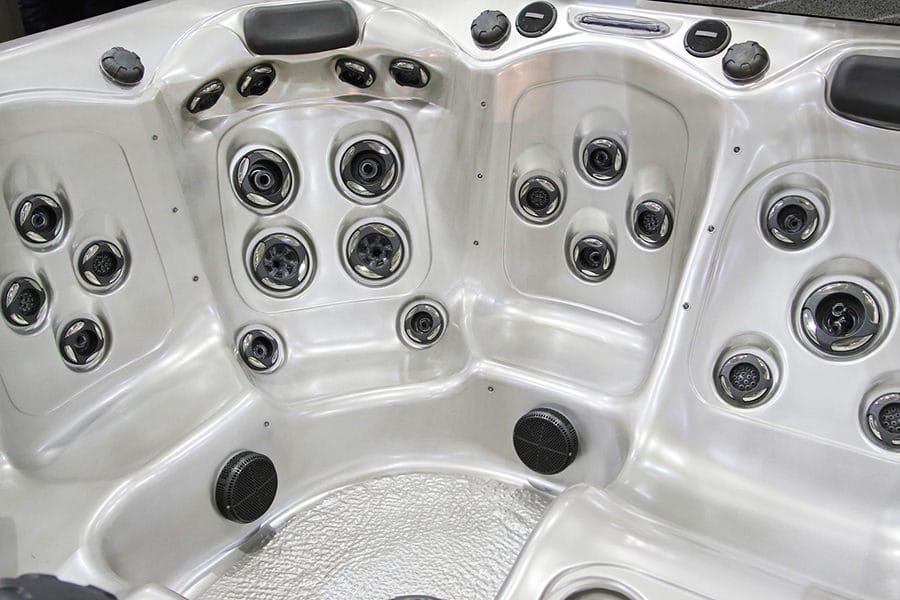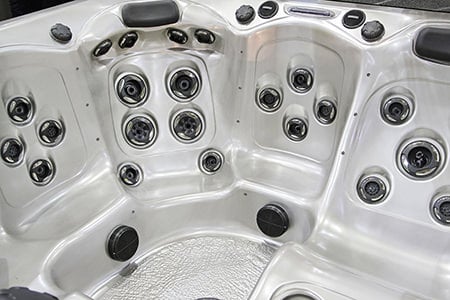
If you’re looking for a new hot tub then the number and quality of the jets is of prime importance. Many people think that the more jets you have in your hot tub the better. However, it’s usually better to think in terms of the quality of the jets rather than how many jets there actually are. I decided to investigate:
So, How many jets does a hot tub need? A basic smaller hot tub will probably be fine with 12 jets. Medium sized hot tubs have around 24 jets whilst larger models can have 50 or more. The positioning of the jets, variety, and quality are far more important than sheer quantity.
You also need to think very carefully about how you are likely to use your hot tub before deciding on how many or what sorts of jets will work for you. Let’s have a look at some of the possibilities.
Are more jets really better?
Are you going to get a better hot tub experience sitting in a seat with 20 jets all to yourself than with 10? There definitely comes a point of diminishing returns when it comes to jets in a hot tub and you are far better of thinking about what you want the jets to do rather than how many of them there actually are.
I think there is a bit of a fixation with the number of jets because it’s an easy thing to quantify. To a certain extent, all hot tubs are made in a very similar way, often with the same components between manufacturers and, in an attempt to impress customers the “jet count” and the number of pumps can sometimes become a bit of an easy way of differentiating on hot tub from another.
So, rather than looking at the number of jets what should you look out for?
Well, it really boils down to what you want to use your hot tub for. If you are just wanting a nice warm relaxing soak then a hot tub with a minimal number of jets will do just fine. However, if you want some serious hydrotherapy massage and have specific areas of your body that you want to concentrate on then the positioning and quality of the jets becomes much more important.
You might, for example, need a daily foot massage, or relief for tightness in your lower back. Having your shoulders massaged or having pillow jets to relax your neck might be a priority for you. Check where the jets are located in relation to your body and see if they correspond to your areas of pain. The most important thing is that you think about what you want from your hot tub experience and look for a hot tub with the best jets to suit.
What types of hot tub jets are there?
Hot tub jets come in an almost infinite number of sizes and configurations but they can be broken down into a few main types:
- Rotational jets. These do what you would expect them to do and air and water move in circles in the water. These are great on the shoulders and neck muscles, back muscles and feet.
- Directional jets. These are basically stationary and you can direct a single string jet of water on one area. This can be good if you want a deeper massage in one particular area – maybe lower back or shoulders.
- Pulsing jets. These produce a pulsing effect which can be very soothing on sore muscles.
- Multi massage. These jets consist of a large number of small holes which divides the water stream into a large number of individual streams.
- Ozone or cluster jets. These generally just provide a simple non-adjustable flow.
Needless to say, all of the above types of jets come in numerous different sizes and also a majority of them are adjustable for different rates and size of flow. The adjustment sometimes also alters the ratio of air to water for either a more direct effect or a more gentle soothing diffused flow.
How many pumps does a hot tub need?
The main thing is to get a good power to jet ratio and, as a rule of thumb 2 pumps per 50 – 60 jets is a good starting point.
However, it’s not that simple as the actual power output of the pump will depend upon the amount of horsepower or HP that it can output. Yes, it’s funny to think of your hot tub in terms of horsepower but that’s how it’s done! Manufacturers will often quote brake horsepower or BHP which is usually a higher and less important number than the continuous horsepower number. BHP just measures the momentary power when the pump starts up and continuous horsepower is the ongoing amount of power it can produce.
The bottom line is that you don’t want hundreds of jets with a low powered pump. Or, more easily confused hundreds of jets with several low powered pumps. You can get a good idea of things by comparing the pump flow rate – most jets need of 10 – 12 GPM (gallons per minute) to be effective. So, if you have say ten jets your pump needs an overall flow rate of between 100 and 120 GPM. Check carefully how many jets your hot tub has and check that the combined flow rate of the pumps will privide between 10 – 12 GPM and you should be OK!
What else should I consider when choosing a hot tub?
Other hot tub buying considerations obviously include size, how many seats you need and price. Be aware that cheaper hot tubs may well cost more in the long run as they won’t last as long and, probably more importantly, they will have less insulation. Having less insulation means that they will cost more to run on a monthly basis. Over a number of years this could add up to a significant amount of money and you might have been better off buying the more expensive hot tub at the outset.
Other considerations include lighting and audio facilities, any other water features and the type of filtration system the hot tub uses. Of prime importance is the warranty and service package that the supplier offers. A hot tub is a major investment and there is little to be gained from not going to a trusted and well reviewed supplier. They will be able to give you expert advice, walk you through all of the options available and help with delivery, installation and servicing as well.
How do I know which is the right hot tub for me?
Once you have created a short list if hot tubs there really isn’t any other way to choose that by actually sitting in them and trying them out. If the hot tub is for the whole family then take them along and see how you all fit in. By the time you get to this stage you will probably make your final decision based on feel and fit.
Hopefully you will be able to shedule a “soak test” and actually try out the hot tubs for real. A lot of suppliers will do this and this is a fun and relatively conclusive way to make your fnal decision. If you can’t do this then sitting in the hot tubs dry will give you some indication of which one is right for you.
Getting the right hot tub is a personal and complex decision. Take your time, ask the manufacturer as many questions as you can and go for what feels right for you.
Related Questions
Can you add jets to a hot tub? You can add jets to a hot tub but you need to be careful that you don’t overstretch the pump. It’s really a job for a professional hot tub engineer to undertake. It’s possible to change the types of jets in your hot tub too, this easier and just requires careful ordering of the right size replacement jet.
How do I unblock a hot tub jet? You can unscrew most jets from their pipes and remove them to clear debris from them. Generally, you can do this from inside the hot tub by twisting to the left. Once out you can clean them, remove any calcium build up and soak them in vinegar overnight.

